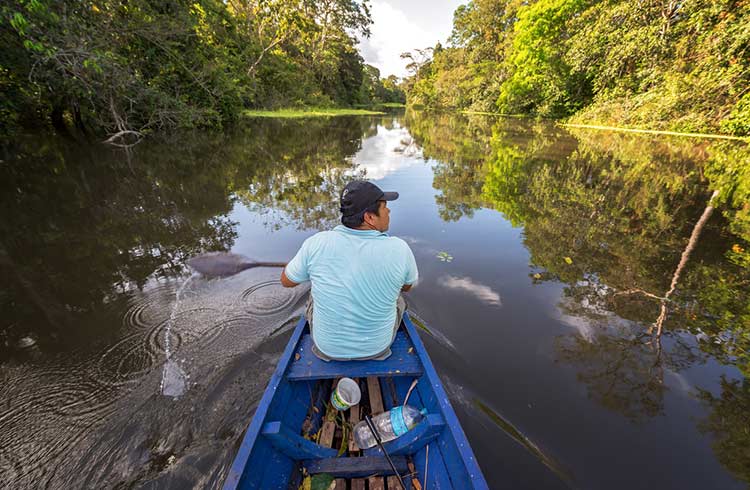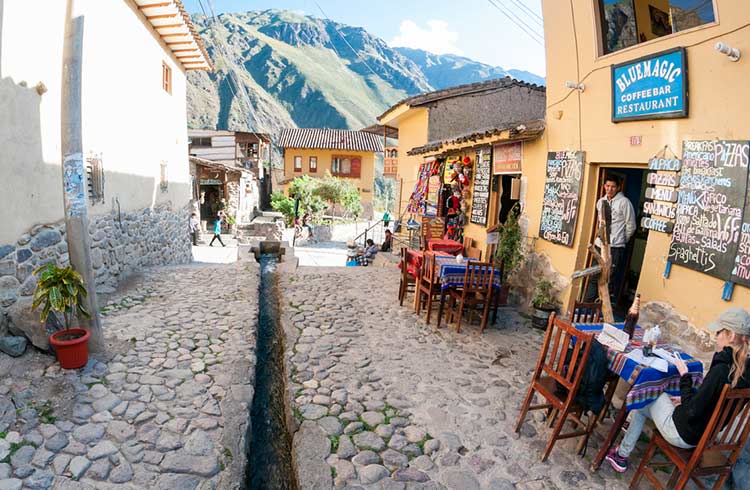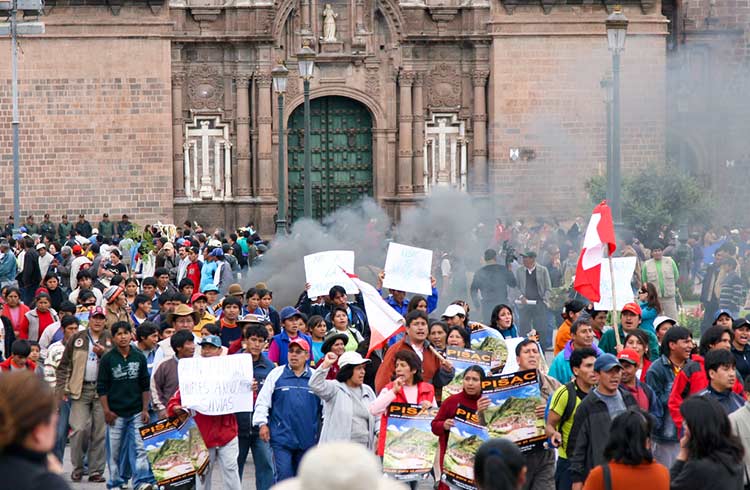How to Stay Healthy While Traveling in Peru
When it comes to travel health concerns, Peru has quite a few. But, there is no need to worry. With a little preparation, you can hopefully travel the country illness-free.
 Photo © iStock/DC_Colombia
Photo © iStock/DC_Colombia
- Medical Treatment in Peru
- Vaccinations Before Going to Peru
- Mosquito and Insect-Borne Diseases
- Water/Food-Borne and Other Diseases
- Altitude Sickness
- Hypothermia
- Sunburn/Heat Exhaustion
- Women’s Health in Peru
- Ayahuasca
Medical treatment in Peru
Most medical facilities are found in Lima and Cusco, with Lima having the highest standards. However, like many countries, places to receive medical treatment are few and far between.
It’s generally recommended that travelers attend a private hospital or a medical clinic as they tend to be better equipped to deal with a wide range of medical emergencies and situations.
Plus, if your Spanish is a little rusty, you’re more likely to encounter English-speaking staff here.
Major chain pharmacies such as Pharmax are found in Lima and Cusco and are open 24 hours. Common medicines and other medical supplies should be available. Always check that the medications are within their expiry date.
It is a good idea to pack your own travel first aid kit including a broad-spectrum antibiotic, anti-diarrhea medication, altitude sickness tablets, and anti-malarials – particularly if you plan to travel outside the urban areas.
The central emergency number in Peru for an ambulance is 117.
What vaccinations do you need for Peru?
Due to the presence of several diseases within Peru, it’s recommended that you receive the following vaccinations eight weeks prior to traveling to the country:
Yellow Fever
The US Centre for Disease Control and Prevention advises US travelers whose itineraries are limited to Lima, Cisco, Macchu Picchu and the Inca Trail will not need a yellow fever vaccination.
Should your trip extend outside these locations or below 7,546ft (2,300m), it’s strongly recommended to receive a yellow fever vaccination as proof will be needed for re-entry into your country.
Australian travelers need to contact their state health authority to find out where they can receive a yellow fever vaccination and international certificate of vaccination as one is required for re-entry into Australia.
Chikungunya
Hepatitis A and B
Hepatitis A (liver infection) is a common problem for travelers and should be considered a required immunization. Once you have completed the series of three shots, given six months apart, you are considered immune to this for life.
Immunity against Hepatitis B is also via a three-shot course of vaccinations.
Typhoid
Rabies
While risk of contracting rabies is low, it may be worth getting the vaccination if you plan to head to remote parts of Peru with limited medical facilities, such as the Peruvian Amazon, or if you plan to do adventure activities like caving (Bats carry the disease and the fungal condition Histoplasmosis is also found in caves).
Despite the risk of rabies reducing in recent years, avoid patting stray dogs.
Tetanus
Occasionally, outbreaks of measles and chicken pox have occurred in Peru, so it pays to check if your routine vaccinations are up to date.
Mosquito and insect-borne diseases
Mosquito and insect-borne diseases are prevalent throughout Peru. Since many of these diseases exhibit similar symptoms, it’s important that you seek medical attention immediately if you’re feeling sick to determine the severity of your illness and receive appropriate treatment.
As with all mosquito and insect-borne diseases, bite prevention is important here.
Here are some particular insect-borne diseases to be aware of if you’re heading to Peru
Yellow Fever
Symptoms: Muscle pain, headache, delirium, vomiting, diarrhea, fatigue, loss of appetite, skin and eyes appear yellow.
Treatment: Vaccination against yellow fever is available. However, treatment is limited to reducing symptoms and making the patient more comfortable.
Pregnant women are advised not to have a live vaccine due to the potential risks exposed to the unborn child.
Zika Virus
Symptoms: Headache, rash (can be present on face and/or body), fever, joint pain, fatigue. Symptoms present themselves 3 to 12 days after the initial mosquito bite.
Treatment: There is no vaccine available, so treatment is limited to reducing the symptoms present.
Dengue Fever
Symptoms: Headache, fever, diarrhea, vomiting, abdominal pain.
Treatment: Like Zika, there is no vaccine available. Treatment for Dengue is limited to reducing the symptoms present.
Malaria
Spread by parasite-infected mosquitos, this disease is found in several countries in South America.
In Peru, malaria is not present in Lima, Cusco, Macchu Picchu, the Inca Trail, and Lake Titicaca. Arequipa, Moquegua, Ica, Nazca, Tacna, Puno, and along the Pacific Coast have also been declared malaria-free.
If you plan to travel to destinations below 6562ft (2000m) like the Peruvian Amazon, it’s recommended that you take anti-malarials before you travel.
Symptoms: Headache, fever, chills, nausea, vomiting, joint and muscle pain. Acute cases include seizures, delirium, respiratory difficulty, and coma. These can develop up to two weeks after being bitten. Some strains of malaria can re-appear months and years after the initial infection.
Treatment: It’s important that if you think you have malaria visit a hospital as soon as possible. If you’re planning to travel to remote areas with limited medical facilities, it’s worth speaking with your doctor before you leave regarding self-treatment until you can attend a high-grade medical facility.
Chikungunya
Symptoms appear seven to ten days after being bitten and include: fever, headache, muscle pain, chills, joint pain and stiffness, fatigue, and rash
Treatment: Based on symptoms present. Most patients recover after a few weeks.
Chagas Disease
Also known as American Trypanosomiasis, this parasitic disease is passed on via the feces of the triatomine or “kissing bugs” via contaminated food and water, or by a scratch or wound. These bugs are generally found living in poorly-built dwellings. While the risk to travelers is low, it is something to be mindful of in rural locations.
Symptoms: Fever, body aches, swelling around the eyes (known as Romaña’s sign), headache, skin rash, swollen lymph glands, diarrhea and vomiting.
Treatment: With anti-parasitic medication. The medication is effective at killing off the parasite providing that medical treatment is sought immediately.
Oroya Fever & Verruga Peruana
Discovered in the late 1800s, this bacterial infection is spread by sand fly bites. It’s generally found in the highlands of the Andes Mountains from 3000ft to 10000ft in elevation in Peru, Ecuador, and Colombia.
Symptoms: During the first stage, you may experience fever, headache, muscle aches, and acute anemia. Subcutaneous lesions which can become ulcerous and bleed occur during the second stage.
Treatment: While the risk to travelers is low, it pays to prevent yourself from being bitten. Often, this condition occurs in conjunction with a Salmonella infection, so antibiotics are administered. Sometimes anti-inflammatories are also required.
Leishmaniasis
This disease is more common in rural areas and it’s thought that people who keep animals inside their dwellings promote potential infection in humans.
Symptoms: Spread by female sandflies infected with Leishmania parasites, Leishmaniasis can present in three ways: visceral (the most serious form which affects internal organs causing swelling of the liver and spleen), cutaneous (skin sores which turn into lesions) and mucocutaneous (destruction of the mucus membranes in the nose, throat and mouth).
Treatment: There is no vaccine available and treatment depends on the type of Leishmaniasis contracted and the location. The visceral type must receive treatment urgently.
Water/food-Borne and other diseases
Sanitation levels vary throughout Peru. Even in rural areas, running water is sometimes non-existent and it pays to take your own toilet paper. Traveler’s diarrhea is a common ailment that can strike you down at any moment, putting a dent in your Peru travels.
By observing good hygiene practices and getting the necessary vaccinations, hopefully, your trip to Peru is a lurgy-free one.
Traveler’s Diarrhea
A frequently-suffered condition, traveler’s diarrhea can really put you back a few days while you travel. Rarely serious, it’s just unpleasant to experience and thought to have come from poor hygiene practices, poor sanitation, and contaminated food and water.
Symptoms: Caused by bacterial nasties like E-Coli, Salmonella, Shingella and Campylobacter, symptoms such as cramping, watery diarrhea, fever, vomiting, and abdominal pain appear six to 72 hours after initial infection.
Treatment: If blood is present, then seek medical treatment immediately. Otherwise, it’s a case of riding it out. Drink plenty of water and electrolyte drinks. If you can’t find Gatorade, a pinch of salt and sugar in a glass of warm water will work too. Stick to dry foods like toast and crackers. Make sure you take time to rest and don’t overdo it. If it’s not getting better after a week, seek medical treatment as you may need antibiotics.
Typhoid
Caused by Salmonella Typhi, typhoid is transmitted via contaminated food and water. Vaccination is strongly recommended before you travel and practicing good hygiene while you travel will help minimize the risk of becoming infected.
Symptoms: The disease incubates over three to five days and the symptoms are similar to many other illnesses such as fever, headache, nausea, muscle ache, constipation or diarrhea, so it is wise to seek medical treatment immediately. Prolonged treatment can lead to serious complications such as internal bleeding, respiratory diseases such as pneumonia, delirium or even death.
Treatment: Antibiotics and fluids.
Gnathostomiasis
This is an emerging disease that is contracted by eating raw fish dishes (such as ceviche) infected with parasitic worms. It’s advised to only consume thoroughly-cooked food if you are unsure about the safety of what you’re about to eat.
Symptoms: Fever, vomiting, stomach pain, headache, and loss of appetite.
Treatment: Anti-parasitic medication. Sometimes, surgery is required.
Hepatitis A
Vaccination is available and advised for travel to South American destinations.
Symptoms: Nausea, fatigue, abdominal pain, jaundice, dehydration, fever and loss of appetite.
Treatment: Hepatitis A is acute and generally clears up within a month or two. There is no specific treatment for Hepatitis A, so doctors will generally provide relief based on the symptoms and rest is advised. Isolation is important to not spread the illness. The Australian Department of Health states that Hepatitis A is contagious two weeks prior to symptoms first appearing to a week after they disappear.
Cholera
Infecting the intestinal tract, cholera is transmitted via food and water contaminated with the Vibrio cholera bacteria.
Symptoms: Acute diarrhea resulting in extreme dehydration. Seizures may also occur.
Treatment: Medical treatment is to be sought immediately as the disease is fatal. You will need intravenous antibiotics, rehydration, and fluids.
Hepatitis B
While the risk to travelers is generally low, it can be transmitted via contaminated medical equipment and blood, poor safe sex practices, or unclean tattooing equipment. Even accidental needles stick injuries. Vaccination against the disease is available.
Symptoms: Sometimes infected people exhibit little or no symptoms of the disease. Jaundice, dehydration, nausea, acute fatigue, and vomiting can be present.
Treatment: Most people infected by Hepatitis B clear up within six months of being infected via their natural immune system. However, anti-viral medication may be needed. The infection builds immunity against future bouts of the disease.
Altitude Sickness
Given many of Peru’s amazing sights are at high altitudes in the Andes, such as Macchu Picchu, Choquequirao Trek, and the Inca Trail, altitude sickness is bound to strike any traveler. Known by the locals as soroche, altitude sickness – if not taken seriously – can be fatal.
However, you can prepare and manage the risk as you ascend to ensure your hiking trip is an exciting and memorable one.
Hypothermia
Hypothermia can pose a real risk for travelers in the Andes Mountains and highland areas. Temperatures can plummet at night, leaving you exposed to the cold and wind. Bring plenty of warm layers including a beanie. Keep as warm and dry as possible, keep active, consume plenty of water and food plus limit your intake of alcohol and caffeine.
Symptoms include numbness, tiredness, chills, delirium, cramps, and slurred speech.
Should you, unfortunately, experience a mild case of hypothermia, it is important to protect the affected area from wind chill or rain, dress warmly and consume hot drinks and food such as soups. Never rub a suspected hypothermia patient as it can result in cardiac arrest.
Seek medical treatment to prevent it from increasing in severity.
Sunburn/heat exhaustion
Peru is situated near the equator and, as a result, the effect of the sun on our health is much stronger than you would experience in latitudes further south or north.
Whether you are walking around Lima, touring Lake Titicaca or hiking along the Inca trail, it is strongly recommended to protect yourself from becoming sunburned or worse, suffering from heat exhaustion or heat stroke.
Always wear a hat and sunglasses, apply broad-spectrum sunscreen (SPF 30+ or higher), and wear light, long-sleeved clothing. Try to limit your activities during the hottest part of the day between 11am and 2pm. Ensure you stay hydrated by consuming plenty of clean water.
Even on overcast days of your trip, make sure you take precautions against the sun.
Women’s health in Peru
Pregnant women should reconsider traveling to Peru due to the risk of Zika virus and Yellow Fever.
If you’re planning to travel outside the major cities of Lima and Cusco, it’s recommended to stock up on sanitary products such as tampons.
The contraceptive pill, condoms etc are rarely found outside urban centers as well.
Sexual assaults against women do happen and should it unfortunately happen, contact your embassy and travel insurance company. Some travelers have reported that the tourist police can sometimes be unhelpful despite rape being frowned upon, so it’s best to contact your embassy immediately for assistance and advice and find the nearest medical treatment facility.
Ayahuasca
Some partake in the hallucinogenic tea for a spiritual awakening, others use it as a means to heal from all forms of pain.
Sacred to the indigenous people of the Amazon, the brew made from the ayahuasca vine has been used in traditional ceremonies administered by shamans for thousands of years.
While thousands of travelers seek retreats in Iquitos and Puerto Maldonado in order to find enlightenment, there have been several cases in recent years where things have gone very wrong, resulting in psychotic damage, crimes against others, and even death.
Ayahuasca retreats in South America are largely unregulated. There are lots of dodgy places with fake shamans willing to part you with your cash for little in return or, at worst, injury or death.
The Ayahuasca Safety Association was established in Peru in 2016, in response to several unfortunate deaths of tourists experiencing the ceremony. The Peruvian Government, retreat operators, psychiatrists, and doctors have come together in order to establish regulation, safety and ethics for this ever-growing industry.
So, how do you sift the responsible retreats from the bad ones? That old saying “If it’s too good to be true, it usually is” applies here. The retreats which tend to have safeguards in place aren’t cheap, but you are putting your life in their hands. Reputable retreats will offer many services and safety measures such as:
- Guest health screening processes to ensure the participant is medically well enough to attend the retreat.
- No drugs or alcohol allowed on site.
- Small group ceremonies are facilitated in English, some also are Spanish/English speaking.
- Numerous male and female staff on hand to make sure those taking part in the ceremony are supported and safe. Those staff will not be under the influence of ayahuasca.
- There is plenty of post-ceremony support and trained staff at the retreat facility.
- First aid is on standby should anyone need medical treatment.
- Professionalism by shamans and staff. There have been reports of sexual assaults against retreat attendees in South America. No ayahuasca retreat should have any form of sexual component in it.
- The brew will be pure with no additives. Only the vine and the leaf should be used.
- There will be comfortable accommodation with meals and essential support services provided. Nutritious food is also provided.
- There may be extracurricular activities such as guided walks, hiking, yoga etc.
- Balance between ceremonies and rest days. Dodgy places will cram in as many ceremonies as possible.
If you do plan to take a retreat, read reviews, do the research and ask as many questions of the venue as possible.
Related articles
Simple and flexible travel insurance
You can buy at home or while traveling, and claim online from anywhere in the world. With 150+ adventure activities covered and 24/7 emergency assistance.
Get a quote


No Comments